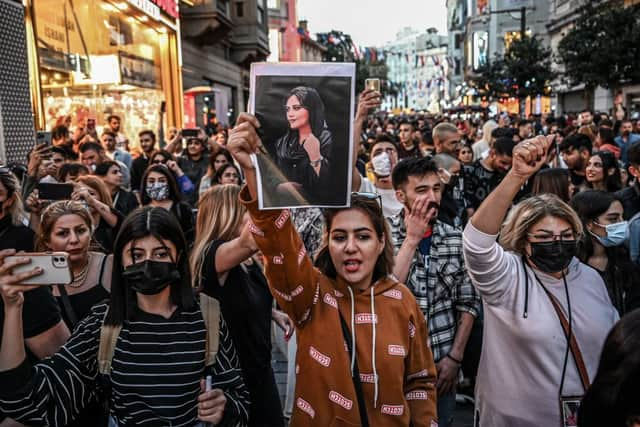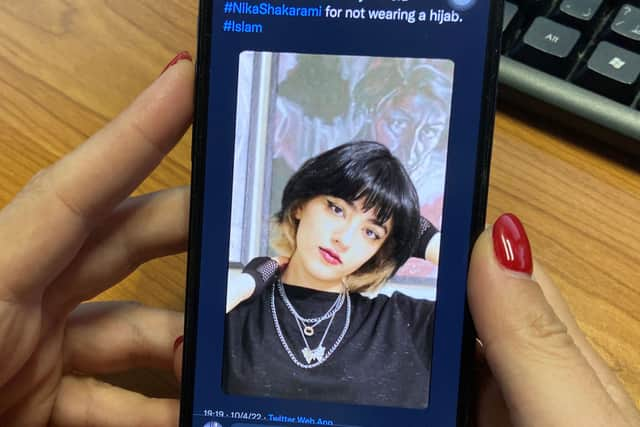Iran: why are women cutting off their hair in protest as part of #HairForFreedom - and who was Mahsa Amini?
and live on Freeview channel 276
Over the past three weeks, Iran has been shaken by protests as women bravely take to the streets to challenge the country’s strict ‘morality’ laws - risking imprisonment by doing so. The unrest was sparked by the death of 22-year-old Mahsa Amini, who was detained by police on 13 September for allegedly violating Iran’s strictly enforced dress code.
According to the country’s morality police, she wore her hijab too loosely. Women in Iran are required to wear their hijab so it covers their hair entirely.
Advertisement
Hide AdAdvertisement
Hide AdThree days after she was imprisoned, the young woman collapsed in a police station and tragically died. While the Iranian government said she died from a “sudden heart attack”, Ms Amini’s family have cast doubt over this and suggested she was killed.
Her death came to highlight for many Iranians, particularly the young, the Islamic Republic’s heavy-handed policing of any form of defiance, as well as the increasingly brutal treatment of young women at the hands of the morality police.


What happened to Ms Amini has thus led to public outcry both in Iran and worldwide, prompting many women and supporters to share photos and videos of themselves cutting their hair or removing their hijabs as a sign of solidarity.
So what exactly is happening in Iran, why are women cutting their hair, and what could happen to demonstrators? NationalWorld has taken a look at the ongoing situation.
Why are women cutting their hair?
Advertisement
Hide AdAdvertisement
Hide AdIn Iran, hair is a sign of beauty that is decreed to be hidden or covered by the Islamic Republic. So for many Iranian women, cutting their hair is a poignant sign of protest.
US-based Persian literary critic Waheed Siddiqi told ABC News: “The religious leaders in Iran have made the veil mandatory for women and girls to completely cover the hair, which is deemed as a symbol of honour and dignity. But this action of the women activists has simply blasted the whole concept of that forceful imposition.”


So women taking to the streets or Iran to cut their hair or remove and burn their hijabs has been a symbol of resistance since the start of the protests - and women and men across the world have joined in as a sign of support.
Who has cut their hair?
In addition to various women across the world who have shared their support for #HairForFreedom on social media, celebrities, politicians and campaigners are now also joining the movement.
Advertisement
Hide AdAdvertisement
Hide AdA group of more than 50 high-profile French actors and musicians, including names Juliette Binoche, Marion Cotillard, Isabelle Adjani and Isabelle Huppert, and Angèle, posted a video of themselves cutting their hair - a video Ms Binoche opens by stating “for freedom”.
In the world of politics, Swedish MEP Abir Al-Sahlani cut her hair in the European Parliament in Strasbourg. "Until Iran is free, our fury will be bigger than the oppressors. Until the women of Iran are free, we are going to stand with you", she said as she chopped off her ponytail in front of fellow MEPs. She ended her speech by saying "Jin, Jiyan, Azadi" - Kurdish for "Woman, Life, Freedom."


Yesterday (6 October), Elika Ashoori, the daughter of Anoosheh Ashoori who was released from an Iranian prison alongside Nazanin Zaghari-Ratcliffe in March, cut her hair live on ITV’s Lorraine.
She said: “I have brought a pair of scissors today to show my solidarity to my sisters in Iran and this pales to the bravery that they’re showing in the streets, risking death. So I’m going to cut my hair as well, just to show that we are all behind you.” She also called for the UK, US and European governments to sanction Iranian government officials, stop trading with Iran, and enforce travel bans.
Advertisement
Hide AdAdvertisement
Hide AdSpeaking on how she believes people have become desensitised to news from the Middle East, Ms Ashoori commented: “People need to not normalise pain and suffering in the Middle East. They need to be enraged. They need to see what is happening to these girls as no different to what would happen anywhere in the world.
“What if they were your sisters, your daughters, your mothers?”
In addition to these women, men are also starting to join the protests. French TikTok user Chan Handpan for example shared a video of himself cutting his hair, writing in the caption: “Solidarity with Iranian women.”
What is happening in the protests?
While those cutting their hair around the world can do so safely, women in Iran are doing so at great risk - and many have died or been imprisoned throughout the duration of the protests.
Advertisement
Hide AdAdvertisement
Hide AdAs Iranians take to the streets in Tehran and at least twelve other cities across the country, they are met by Iran’s morality police - known as the Guidance Patrol. This force is there to enforce Iranian society’s strict ‘morality’ laws, which stipulate what people can - or cannot - do, say and wear.


Stationed in most public places, members from this police force have been vehemently cracking down on protesters. Hundreds have been arrested, and human rights organisations are saying hundreds have likely died. On 4 October, 16-year old Nika Shakrami was added to the death toll. She was buried on what would have been her 17th birthday.
The protests are reportedly the most serious in the country since 2019, when demonstrators rebelled over a hike in the price of gasoline. According to the Human Rights Watch, during these past three weeks, Iranian courts have issued or upheld at least four execution sentences in connection to the protests.
Comment Guidelines
National World encourages reader discussion on our stories. User feedback, insights and back-and-forth exchanges add a rich layer of context to reporting. Please review our Community Guidelines before commenting.
